Canada Thistle
by K.G. Beck * (Revised 11/13)
Quick Facts…
- Canada thistle is a creeping perennial that reproduces from vegetative buds in its root system and from seed.
- It is difficult to control because its extensive root system allows it to recover from control attempts.
- Combining control methods is the best form of Canada thistle management.
- Persistence is imperative so the weed is continually stressed, forcing it to exhaust root nutrient stores and eventually die.
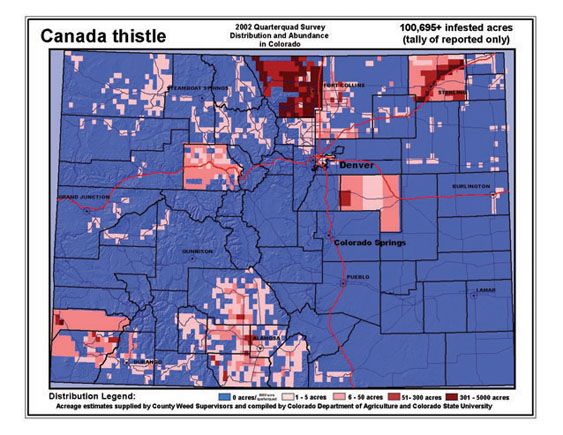
Figure 1. 2002 distribution of Canada thistle in Colorado. |
Canada thistle (Cirsium arvense) is an aggressive, creeping perennial weed that infests crops, pastures, rangeland, roadsides and noncrop areas. Generally, infestations start on disturbed ground, including ditch banks, overgrazed pastures, tilled fields or abandoned sites. Canada thistle reduces forage consumption in pastures and rangeland because cattle typically will not graze near infestations. In 2002, the Colorado Department of Agriculture surveyed counties and while incomplete, the results showed more than 100,000 acres infested with Canada thistle (Figure 1).
One plant can colonize an area 3 to 6 feet in diameter in one or two years. Canada thistle grows in a variety of soils and can tolerate up to 2 percent salt content. It is most competitive in deep, well-aerated, productive, cool soils. It usually occurs in 17- to 35-inch annual precipitation zones or where soil moisture is adequate. It is less common in light, dry soils. A survey conducted in 1998 showed Colorado has about 400,000 acres infested with Canada thistle.
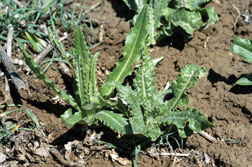
Figure 2. Emerged Canada thistle rosettes from roots in early spring. |

Figure 3: Canada thistle bolting growth stage in spring. |
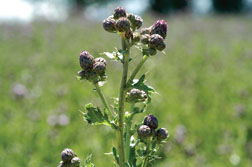
Figure 4. Canada thistle in the late bud growth stage. |
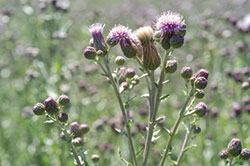
Figure 5. Canada thistle in flowering growth stage. |
Phenology
Emergence. Canada thistle develops from seed or vegetative buds in its root system. Horizontal roots may extend 15 feet or more and vertical roots may grow 6 to 15 feet deep. Canada thistle emerges from its root system in mid- to late spring (late April through May) and forms rosettes (Figure 2).
The greatest flush of root-derived plants occurs in spring, but another flush occurs in fall. A flush can occur anytime during the growing season when soil moisture is adequate. This is particularly a problem when Canada thistle growth is disturbed by tillage or herbicides. This feature can be manipulated to the land manager’s advantage.
Plants that germinate from seed do so at about the same time as root-derived shoots. Seedlings grow slowly and are sensitive to competition, particularly if shaded. Canada thistle seedlings develop a perennial habit (the ability to reproduce from their root systems) about seven to eight weeks after germination.
Reproduction and spread. Canada thistle begins to flower in late spring to early summer in response to 14- to 16-hour days (Figures 3, 4 and 5). Plants are male or female (dioecious) and grow in circular patches that often are one clone and sex. Female flowers produce a sweet odor and insects readily pollinate different sexed patches up to 200 feet apart.
Canada thistle develops seed sparingly. It may produce 1,000 to 1,500 seeds per flowering shoot. Generally, vegetative reproduction from its root system contributes to local spread and seed to long distance dispersal. Seed may be transported long distances by water, or attached to animals, clothing, farm equipment and other vehicles, and in contaminated crop seed. Also, wind may help disperse seed, but most often, the feathery pappus breaks off, leaving the seed attached to the parent plant to be dispersed by other means. Seed can remain viable in soil up to 22 years, and deep burial promotes survival longevity.
Canada thistle allocates most of its reproductive energy into vegetative propagation. New shoots and roots can form almost anywhere along the root system of established plants (Figure 6). Tillage segments roots and stimulates new plants to develop. Shoots emerge from root and shoot pieces about 15 days after disturbance by tillage. Small root pieces, 0.25 inch long by 0.125 inch in diameter, have enough stored energy to develop new plants. Also, these small roots can survive at least 100 days without nutrient replenishment from photosynthesis.
Management
The key principle to Canada thistle control is to stress the plant and force it to use stored root nutrients. Canada thistle can recover from almost any stress, including control attempts, because of root nutrient stores. Therefore, returning infested land to a productive state occurs only over time. Success requires a sound management plan implemented over several years.
Cultural control. Grasses and alfalfa can compete effectively with Canada thistle if their growth is favored by good management. Maintain fertility and, if possible, moisture at optimum levels to favor grass or alfalfa growth. Soil analysis can easily determine fertility needs. Be cautious with nitrogen fertilizers, because excess available soil nitrogen may favor weed growth.
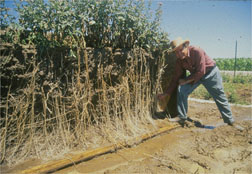
Figure 6. Canada thistle root system after 14 months growth from 25 vegetative shoot cuttings. |
These are essential management steps to ensure optimum desirable plant growth and competition. However, competition alone seldom is effective against Canada thistle.
Chemical control. Read the label, follow directions and use precautions. Research at Colorado State University shows that Tordon 22K (picloram), Milestone (aminopyralid), Transline (clopyralid), Perspective (aminocyclopyrachlor + chlorsulfuron), Banvel/ Vanquish/Clarity (dicamba), and Telar (chlorsulfuron) are effective against Canada thistle in pastures, rangeland, natural areas, and noncrop settings. Canada thistle is difficult to control and re-treatment for one to three or more years after the initial application is common. Refer to Table 1 for use rates and application timing and always read the herbicide label before using the product. These herbicides are most effective when combined with cultural and/or mechanical control.
| Table 1. Herbicide to control Canada thistle in pasures, rangeland, natural and noncrop areas. | |||
| Herbicide | Rate (Product/A) | Application timing |
Comments |
| Tordon | 1 quart | Anytime when weeds are rapidly growing | Fall applications consistent results; may need re-treatment 1 to 2 years |
| Milestone | 5 to 7 fl oz | Spring at pre-flower-bud growth stage; or fall | Use higher rate for older or dense stands; Milestone may be used to edge of ponds or streams; may need re-treatment 1 to 2 years |
| Transline | 0.67 to 1.33 pints | Spring after all shoots have emerged, rosette to early bud growth stages; or fall | Apply 1 pint/A or more in fall; may need re-treatment 1 to 3 years |
| Perspective | 5.5 oz | Spring rosette to flower bud growth stage; or fall | Use with a non-ionic surfactant at 0.25% v/v |
| Telar | 1 oz | Spring bolting to bud growth stages; or fall | Fall applications most consistent results; essential to use non-ionic surfactant at 0.25% v/v; may need retreatment 1 to 2 years |
| Banvel,Vanquish, or Clarity
(dicamba) |
2 quarts | Spring rosette growth stage; or fall | Fall applications most consistent results; may need re-treatment 2 to 4 years |
Colorado State University data also indicates that Banvel/Vanquish/Clarity or Telar are effective when combined with 2,4-D as a split-season application.
Apply 2,4-D, 2 quarts per acre (A), in spring when Canada thistle is 10 to 15 inches tall, in pre-bud to early bud growth stages. Re-treat in fall with Banvel/Vanquish/Clarity (2 quarts/A) or Telar (1 ounce/A) to re-growth. Use a surfactant (0.25 percent to 0.5 percent v/v; equivalent to 1 to 2 quarts of surfactant per 100 gallons of spray solution) with Telar for adequate control. Perspective should be applied in spring from the rosette to flower bud growth stages or in fall. CSU research shows that aminocyclopyrachlor (one of the Perspective components) and aminopyralid (Milestone) are absorbed primarily by the root system.
Curtail is clopyralid plus 2,4-D and is effective on Canada thistle but control tends to be less than from Transline. Research at Colorado State University shows that the performance of Curtail to control Canada thistle can be improved when preceded by two or three mow¬ings. When Canada thistle infestations occur in situations where root growth would be restricted, such as habitats with high water tables, begin mowing when it is 12 to 15 inches tall. Repeat mowings at about one month inter-vals. Apply Curtail at 2 to 3 quarts/A in October or about one month after the third mowing. Follow this regimen for two consecutive years.
Mechanical control. Mowing hay meadows can be an effective tool if combined with herbicide treatments. Mowing alone is not effective unless conducted at one-month intervals over several growing seasons. Always combine mowing with cultural and chemical control. Mowing at hay cutting stimulates new Canada thistle shoots to develop from its root system.
In irrigated grass hay meadows, fall herbicide treatments that follow mowing can be an effective management system because more Canada thistle foliage is present after cutting to intercept herbicide. Additionally, root nutrient stores decrease after mowing because the plant draws on them to develop new shoots.
If a Canada thistle infestation exists in a field that will be rotated to alfalfa, control the weed before seeding alfalfa. Alfalfa is an effective competitor only after it is established. It will not adequately establish in a well-developed Canada thistle infestation. A Canada thistle management system can start with crop or grass competition combined with herbicides, with the field rotated to alfalfa when the management plan ends.
Biological control. Ceutorhyncus litura is a weevil currently used as a biocontrol agent in Colorado. The female lays eggs on the underneath side of Canada thistle leaves in early spring. Larvae bore into the main leaf vein, then down into the plant’s crown area. If the population is high enough, plant death can occur, otherwise Canada thistle is stressed and less vigorous.
Ceutorhyncus alone will not effectively control Canada thistle. It must be combined with other methods to be successful. Combine the weevil with cultural techniques that allow for maximum desirable plant competition. Research to combine Ceutorhyncus with herbicides or mowing has not been conducted. Research has shown that biological and chemical controls are compatible for musk thistle. This is most likely true for Canada thistle as well. Ceutorhyncus litura is available from the Colorado Department of Agriculture.
Urophora cardui is another biocontrol insect available from the Colorado Department of Agriculture. Females lay eggs on apical meristems of developing shoots. Larvae burrow into shoots. Their feeding triggers huge galls to form that stress the plant, sometimes killing it. Galls that form near the terminal meristems (e.g., where flowers develop) keep the weed from flowering and reduce seed set.
*Colorado State University Extension weed science specialist and professor, bioagricultural sciences and pest management. Revised 11/13.
Colorado State University, U.S. Department of Agriculture, and Colorado counties cooperating. CSU Extension programs are available to all without discrimination. No endorsement of products mentioned is intended nor is criticism implied of products not mentioned.
Go to top of this page.





